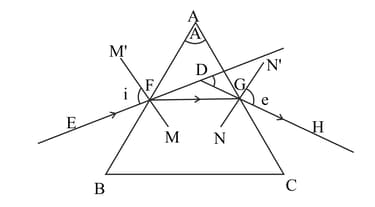Refraction of Light through a Prism
Refraction of Light through a Prism: Overview
This topic covers concepts, such as, Angle of Prism, Prism and Deviation by Prism etc.
Important Questions on Refraction of Light through a Prism
A thin prism of angle is placed at a distance of from the object. The distance of the image from the object is (given of prism)
A ray incident at angle 53o on a prism emerges at an angle at 37o as shown. If the angle of incidence is made 50o, which of the following is a possible value of the angle of emergence.
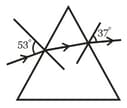
A parallel beam of light falls normaly on the first face of a prism of small angle. At the second face it is partly transmitted and partly reflected, the reflected beam striking at the first face again, and emerging from it in a direction making an angle 6o 30' with the reversed direction of the incident beam. The refracted beam is found to have undergone a deviation of 1o 15' from the original direction. Find the refractive index of the glass and the angle of the prism.
The refractive indices of the crown glass for violet and red lights are and respectively and those of the flint glass are and respectively. A prism of angle is made of crown glass. A beam of white light is incident at a small angle on this prism. The other thin flint glass prism is combined with the crown glass prism such that net mean deviation is anticlockwise.
A screen is placed normal to the emerging beam at a distance of from the prism combination. Find the distance between red and violet spot on the screen. Which is the topmost colour on screen.
A ray of light undergoes deviation of when incident on an equilateral prism of refractive index What is the angle subtended by the ray inside the prism with the base of the prism is ?
A given ray of light suffers minimum deviation in an equilateral prism . Additional prism and of identical shape and of the same material as are now added as shown in the figure. The ray will now suffer

A given ray of light suffers minimum deviation in an equilateral prism . Additional prism and of identical shape and of the same material as are now added as shown in the figure. The ray will now suffer

is prism respectively. Incident Ray is perpendicular to . Critical angle of prism material is degree and refractive index is . Calculate angle of emergence
A glass prism of absolute refractive index of is surrounded by a medium. The emergent rays are bent either upwards or downwards.
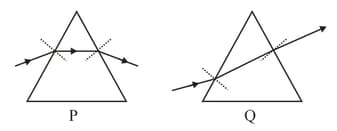
Select the suitable surrounding mediums from the given table of refractive indices here for each of the above refractions through the prisms P and Q. Give reason for the choice of the mediums.
| Medium | Refractive index |
| Benzene | |
| Carbon disulphide | |
| Ethyl alcohol | |
| Aqueous sodium chloride |
In the given combination of three triangular prisms, a ray of light enters the first prism on the left and exits from prism on the right after refraction. Consider the angles of the prisms to be small and the ratio .
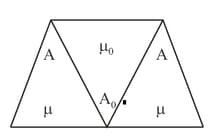
Prove that for a net deviation produced in the light ray to be zero, in the given combination.
The cross-section of a glass prism has the form of an isosceles triangle. One of the refracting faces is silvered. A ray of light falling normally on the other refracting face, being reflected twice emerges through the base of the prism perpendicular to it. Find the angles of the prism.
The angle of minimum deviation for a glass prism with equals the refracting angle of the prism. What is the angle of the prism?
A ray coming from an object is reflected totally at the slant surface of the prism. The possible orientation of the image is
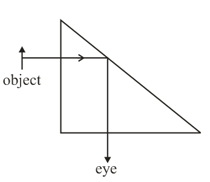
A beam of light consisting of three colours namely red (R), Green (G) and yellow (Y) is incident on the prism as shown below. Complete the diagram to show refracted and emergent ray.
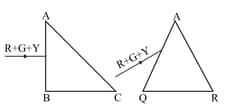
(a) A ray of light of wavelength falls normally on a right-angled isosceles prism of refractive index .
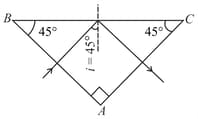
Find the minimum value of refractive index of the prism required for the total internal reflection of the light to occur on the face of the prism.
(b) For any given thin prism of small angle , refractive index , and an incident blue light, answer the following questions.
i. Write the formula for angle of minimum deviation for a thin prism. If the whole arrangement is immersed in a liquid of refractive index , how will the angle of minimum deviation change?
ii. For some angle of incidence on the second face of the prism, the incident blue light undergoes total internal reflection. However, a red incident light for the same angle of incidence on the second face of the prism does not undergo total internal reflection. Give reason.
Consider a refracting media of refractive index kept in air and surrounded by two non parallel surfaces, such that one surface is fixed and another surface is being moved with constant angular velocity about point in clockwise direction as shown in figure. Assume that refractive media bounded by nonparallel surfaces always remains isotropic and refractive index always remains constant. A light ray falls on fixed surface at angle of incidence Choose the correct option(s). Angle of prism
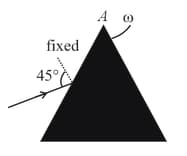
A ray is incident normally on a right angle prism with and The ray strikes a glass sphere at a height of above the principal axis. The other half of the sphere is silvered. Find the total deviation (in degrees) the ray suffers.
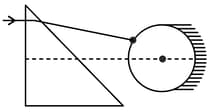
Explain refraction of light ray through a prism.
Define prism. What are the terms associated with it?
In the given figure, is the deviation.
